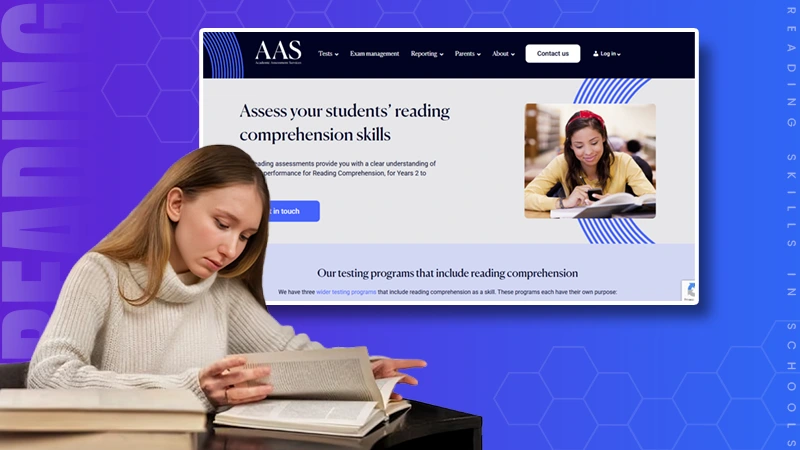
A good teacher isn’t someone who gives the answers out to their kids but is understanding of needs and challenges and gives tools to help other people succeed.” — Justin Trudeau.
As teachers, we strive for our students to succeed with reading, but how do we evaluate their growth in a useful manner?
It’s apparent that so many students require extra focus and help when approximately 40% of fourth graders are reading at or below the basic level (Source: KNWA FOX 24, 2025).
This blog post discusses 10 recommendations that are designed to help evaluate reading ability in schools and go beyond the traditional use of achievement tests.
These strategies will help you enhance your assessment methods and give you the capability to provide precise and effective aid to your student’s reading growth. Stay tuned with us!
1. Use a Range of Assessment Tools
Using a single tool is not enough if you are looking to effectively test school students’ reading abilities.
Combining different approaches such as comprehension quizzes and simple observational quizzes provides a clearer picture of every learner’s capabilities and progress.
In this manner, it is much easier to identify their areas of strength and areas requiring more direction.
2. Monitor Reading Fluency
Reading fluency serves as a proxy indicator for students’ reading abilities and it includes everything in the reading portion such as speed and accuracy, along with the proper flow.
To monitor reading fluency, you require some (RFPM) reading fluency progress monitors.
This can include oral reading that measures the student’s progress, another one is the word count, which helps in counting the correctly read words per minute.
In this manner, you can encourage them to take steps that will strengthen their reading ability and their self-confidence.
3. Assess Comprehension
Assess comprehension includes examining how effectively an individual can understand the meaning of the text.
This involves identifying the important details, drawing conclusions, making logical references, and relating the concepts with the words.
The picture mentioned below can help you to understand the reading comprehension.

In this assessment, you can ask comprehensive questions and tell the student to retell it in their own words.
4. Conduct Running Records
Conducting running records of the students’ errors can make them aware of their mistakes and clarify a particular point where they need to make improvements.
You have to analyze and observe the oral reading behavior and note each word they are pronouncing correctly or not.
It is used to monitor students’ reading process, reading level, fluency, comprehension, and growth over time.
5. Encourage Student Self-Assessment
To encourage student self-assessment, you can tell them to make their checklist and improve it before starting a new assignment.
And also to make it engaging by transforming this into a type of activity or game in which students check and analyze the mistakes of their fellow players.
These practices will encourage them to identify their progress, strengths, and weaknesses.
Also, it will lead to the development of self-direction, and critical thinking, and promote excitement for the studies.
6. Integrate Technology
Reading with digital tools and platforms can make the reading and comprehension better, to understand.
As in gadgets, students can adjust the size and font, highlight the key points, and text-to-speech, all these tech features will make the words easier to read.
For those children who are struggling with reading or learning a new language, they can use the feature of text-to-speech.
These applications allow you to address the questions and quizzes according to your difficulty level.
7. Assess Vocabulary Development
Vocabulary is incredibly pivotal for students, as you know, since you work as a teacher, which makes it even more necessary for students to be able to identify terms correctly.
You can test their vocabulary knowledge by giving them questions, and options to choose from, doing exercises from the reading books, and evaluating their written pieces.
Also, you must ensure these measurements coincide with their age and reading capabilities for maximum effectiveness.
Key points to consider when assessing vocabulary development in reading:
- Direct vocabulary knowledge:
- Definition checks: You can ask students to define keywords from the text directly.
- Synonym/antonym identification: Let them pick up words with similar or opposite meanings.
- Multiple-choice questions: Presenting a word with several possible definitions and asking students to select the correct one.
- Sentence completion: You can provide a sentence with a missing word and ask them to choose the most appropriate word from a list based on the context.
- Cloze activities: Remove certain words from a passage and ask them to fill them in based on the surrounding context.
- Open-ended questions: Also, ask them to explain how a specific word is used in the text and why it is pivotal.
8. Implement Peer Assessments
This type of assessment helps students to jointly check each other’s work, which helps to appreciate other people’s points of view.
This approach is meant for group work, fosters creativity, and makes students recognize their strengths and weaknesses.
9. Provide Timely Feedback
As learners receive feedback on tasks after completing them, they become aware of what achievement looks like and what still needs to be accomplished.
Thus, giving them sage feedback not only inspires them but is also very useful in guiding them.
10. Use Benchmarking
Using benchmarks means measuring student results against a set standard or grade level expectation.
This helps give you an idea of what the average performance of your students is in comparison to other learners.